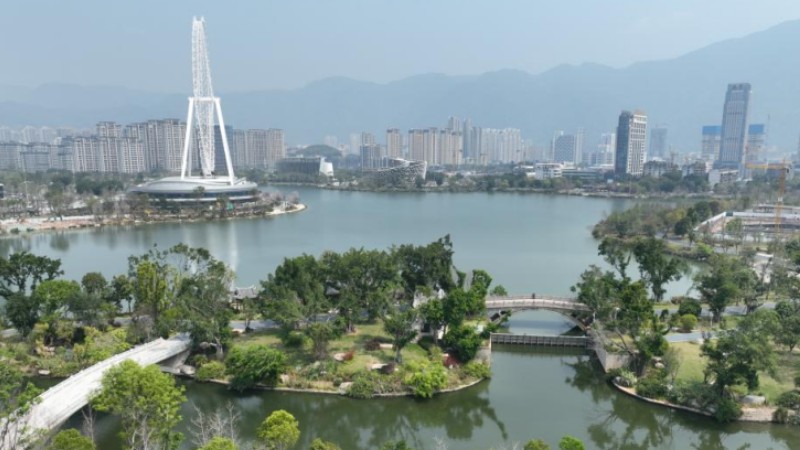China's COVID policy shift saves lives, spurs economic recovery
BEIJING, March 24 (Xinhua) -- In the early spring of 2023, the roads in Beijing are teeming with cars and the air is filled with the heady scent of possibility. The COVID-19 pandemic has seemingly become a thing of the past.
However, China's epidemic response should not be forgotten, and people should not be misled when talking about the issue. The country, with a population of over 1.4 billion, has emerged from the pandemic with strong signs of economic recovery. It only took about three months, without the chaotic back-and-forth seen in some parts of the world where the timing of the exit was not well-planned.
In retrospect, China's COVID-19 response optimization was well-coordinated, effective and grounded in fact.
RIGHT TIMING
The pivotal decision to implement a massive policy shift can be traced back to a key Party leadership meeting held on Nov. 10 last year. During the meeting, the Standing Committee of the Political Bureau of the Communist Party of China (CPC) Central Committee deliberated on how to best optimize the country's epidemic prevention and control measures.
The very next day, a set of 20 optimization measures were announced, including a reduction in quarantine periods for close contacts and inbound travelers, stopping the identification of secondary close contacts, and limiting nucleic acid tests to only people in high-risk positions or in key groups.
The policy change was justified by developments on the ground.
A report prepared by the State Council joint COVID-19 prevention and control mechanism said it was necessary to make the change given the weakening pathogenicity of the virus, a high vaccination rate among the population, and the need to effectively coordinate the epidemic response with economic and social development.
According to virologists, the dominant Omicron variant in China at that time was highly transmissible but showed no signs of any marked increase in pathogenicity. In addition, more than 90 percent of Chinese people had been fully vaccinated against COVID-19.
Meanwhile, three years of COVID-19 prevention and control had laid a solid foundation for the country to make the policy shift. China had equipped itself with technology and drugs that are proven to be effective in COVID-19 diagnosis and treatment, and had made continuous progress in terms of pathogen detection and epidemiological investigation.
In short, while the virus was becoming weaker, the Chinese people were becoming better equipped to fight it.
CONSULTATION AND PREPARATION
On Nov. 30, Sun Chunlan, then vice premier, convened a meeting with top experts from disease prevention and control, vaccine R&D, public health and critical care medicine, seeking their advice on further relaxing COVID-19 controls.
The next day, Sun called another meeting to hear the opinions of eight representatives of those fighting the virus at the grassroots level.
Days later, a meeting of the Political Bureau of the CPC Central Committee was held, stressing efforts to optimize epidemic response and better coordinate it with economic and social development.
Consequently, 10 new measures were announced to ease restrictions on visits to public venues and travels, and to reduce the scope and frequency of mass nucleic acid testing.
Localities worked at full speed to ensure that medical resources could meet the demand.
To address a temporary shortage of drug supplies caused by a spike in infections and hoarding, the government provided all the support to pharmaceutical manufacturers in increasing the production of drugs and medical equipment.
The daily output of COVID-19 test kits expanded from 60 million to 110 million within a month. The daily output of medicines such as ibuprofen expanded by over four times.
During the infection peaks, the country managed to increase its intensive care unit beds by 20 percent; at the height of COVID-19 infections, their occupancy rate didn't reach the critical mark of 80 percent.
Jean Christian Nzengue, a Gabonese surgeon in the city of Guangzhou, said China has coordinated medical resources to increase the capacity of hospitals and supplied more equipment and medications for the treatment of severe cases.
"Government, doctors, nurses, volunteers and every single citizen are doing their part and contribution to ensure a victory in the battle against the virus," he said.
On Jan. 8, China downgraded the management of COVID-19, putting it on a par with HIV and viral hepatitis rather than the more serious infections such as bubonic plague and cholera.
NORMALCY IS RESTORED
During the transition phase, more than 200 million patients were treated in a timely manner, including nearly 800,000 patients in a serious condition.
Moreover, the country's COVID-19 mortality rate remains at the lowest level in the world.
A Party leadership meeting in mid-February declared a major and decisive victory in the fight against COVID-19. It said China has accomplished a remarkable feat in the history of human civilization, in which a highly populous nation has successfully pulled through a pandemic.
"This wave of outbreaks has passed. China has stood the test of the pandemic," said Liang Wannian, a leading epidemiologist. "We have built an immunity barrier against the virus."
Life has returned to normal. So have production and business activities.
In February, China's manufacturing purchasing managers' index reached 52.6 percent, the highest point in nearly 11 years.
Retail sales of consumer goods rose 3.5 percent in the first two months of 2023, reversing declines seen in the previous three months.
Economists said the recovery of key indicators is driven by the smooth transition of COVID-19 response.
Meanwhile, many executives and business owners are expressing a sense of optimism, knowing that they can now move forward with their plans in China.
For Oliver Blume, chairman of the Board of Management of Volkswagen AG, his recent business trip to China proved a definite source of optimism.
"China is the most important market for us, and we will continue to expand our product lineup in the country," Blume said in an interview with Xinhua.
With such economic vitality, China has set an impressive gross domestic product growth target of around 5 percent for 2023. The government aims to create around 12 million urban jobs and keep inflation at around 3 percent.
Credit rating agency Fitch Ratings revised its forecast for China's economic growth in 2023 to 5 percent from 4.1 percent. Bank of America and Morgan Stanley also raised their forecasts to 5.5 percent and 5.7 percent, respectively.
Kristalina Georgieva, managing director of the International Monetary Fund, said China's optimization of its COVID-19 policy will likely be the single most important factor for global growth in 2023.
Had China adjusted its COVID-19 policies only because, as certain Western media have claimed, it had no choice but to do so, the populous country would not have been able to bounce back in such a short time and send such strong signals of economic recovery, according to analysts.
Photos
Related Stories
- Commentary: The distorted Western narrative on China's epidemic response
- Commentary: Politicizing COVID-19 origin-tracing misleading, harms fact-seeking efforts
- Commentary: Reviving "lab-leak" theory of COVID-19 irresponsible, senseless
- How China contributed to global anti-COVID fight, economic recovery
- China's COVID-19 response completely right, highly effective: premier
Copyright © 2023 People's Daily Online. All Rights Reserved.









